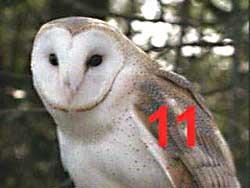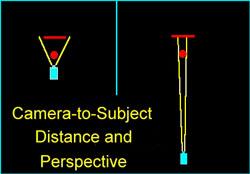Module 11 |
|
Lenses: Distance, Speed and Perspective Changes
Lens focal length differences affect more than just the size of the image on the camera target. It also affects:
|
|
A long focal length lens coupled with a great camera-to-subject distance appears to compress or reduce the distance between objects in front of the lens. The drawing on the right illustrates how the photos below were taken.
The woman remained at exactly the same place when each photo was taken. But in the photo on the right the fountain in the background appears to be much closer to her.
To compensate for this difference and keep the size of the woman about the same in each photo different lens focal lengths were used - a wide-angle lens with a short focal length for the first photo and a telephoto with a long focal length for the second.
This gets a bit tricky, so stay with me here. Let's say that in the setting above, we used the wide-angle lens while standing at the distance used for the telephoto picture on the right-which in this case was about 30 meters (100 feet). Then, let's assume that we enlarged a section out of the resulting very wide shot to equal to the area covered by the telephoto lens (the photo on the right above). The result (although grainy and blurry due to great enlargement) would have the same fountain-to-woman distance perspective as the photo on the right. Although you might think this much-to-do-about-nothing, this
becomes important in understanding the effects of zoom lenses on subject matter-not
to mention such things as court cases involving "wandering road signs!" The Case of the A court case was reportedly launched a number of years ago by a group opposed to the addition to more road signs along an highway-a noble goal, unless you happen to be in the advertising business. Advertisers defended the construction of new signs by saying
that the existing signs had been placed far enough apart that new ones would not
create a cluttered appearance. So to try to settle it, the judge asked that photos be introduced as evidence. Both sides employed photographers who understood the effect of subject-to-camera distance on spatial relationships. As luck would have it, each photographer selected approximately the same group of signs to illustrate the case. The photographer who was hired to show how close together the existing signs were backed up a great distance and used a very long lens; consequently, the distance between billboards was greatly compressed making them appear as if they were already crowded together (similar to the photo above that shows a lot of advertising clutter, and similar to the shot of the woman above who looks as if she could be getting wet from the spray from the fountain). The photographer representing the advertisers moved in close to the first sign and used a wide-angle lens. That made all the signs appear to be far apart. (No sign clutter here!) This is similar to the distance that seems to be between the woman and the fountain in the photo on the left above. Seeing the dramatic difference between the photographs (and
possibly believing "the camera never lies"), the judge reportedly assumed that some
sort of fraud had taken place and disallowed all photo evidence. (Now you know more
about these things than the judge did!) Changes in the Apparent Speed of Objects In addition to affecting the apparent distance between objects, changes in camera-to-subject distance coupled with changes in lens focal length also influence the apparent speed of objects moving toward or away from the camera. By moving away from the subject matter and using a long focal length lens (or a zoom lens used at its maximum focal length), the speed of objects moving toward or away from the camera appears to be reduced (slowed down). This knowledge has been used many times in films. In one of the closing scenes in the famous film, The Graduate, Dustin Hoffman was running down a street toward a church to try to stop a wedding. (The woman he was in love with was marrying another man!) A lens with a very long focal length was used to convey what the character was feeling: that even though he was running as fast as he could, it seemed as if he was hardly moving-and that he would never make it to the church in time. Conversely, moving in close to subject matter with a wide-angle lens increases (exaggerates) the apparent speed of objects moving toward or away from the camera. If you think about this for a moment you can easily visualize why. If you were standing on a distant hilltop watching someone run around a track, or watching traffic moving on a distant roadway, it would seem as if they were hardly moving. (Sort of like watching it with a long focal length lens.) But, stand next to the track or roadway (using your visual wide-angle
perspective) and the person or car would seem to whiz by at a much greater speed.
Perspective Changes
If a videographer uses a short focal length lens in shooting
a tall building from the street level, the parallel lines along the sides of the
building will Compare the photo above taken with a wide-angle lens above with the photo on the right taken at a much greater distance with a normal focal length lens.
When an extreme wide-angle lens is used and you get very close to subjects, you get even more distortion. (Note the two photos above.) Unless this type of distortion is desired, the solution is to move back and use the lens at a normal to telephoto setting . Here's another example. Note the convergence of lines in the photo of the video switcher
on the right. A close camera distance coupled with a wide-angle lens setting makes
the rows in the foreground look much further apart than those in the background.
Again, this type of "distortion" could be virtually eliminated by moving the camera
back and using a longer focal length lens. What's Normal? When it comes to human behavior, psychologists have been debating this question for decades. With lenses, what's normal in terms of a "normal focal length" is comparatively easy to determine. The human eye has a focal length of about 25mm and covers a horizontal area of about 25 degrees. Since we are used to seeing the world in this perspective, this 25-degree angle represents a normal perspective for film and TV cameras. However, in the latter case, "normal" depends on the focal length of the camera lens, and that depends on the area (size) of the film or target. (The bigger the film or target area, the greater the normal focal length of a lens needs to be to optically cover the area.) Therefore, with video cameras the normal focal length is tied to the target or image size.. Still photographers have a good rule
of thumb. Using the same rule, a normal focal length for a video camera can be defined as the distance from one corner of the target area to the opposite corner. If the diagonal distance on the target of a video camera is 20mm, then a lens used at 20 mm on that camera will provide a normal angle of view under normal viewing conditions. Now, if we could just quantify normal human behavior as easily. |

 Compressing
Distance
Compressing
Distance
 Camera distance=
Camera distance= 
 The use of a wide-angle lens combined with a limited
camera-to-subject distance also creates a type of perspective distortion.
The use of a wide-angle lens combined with a limited
camera-to-subject distance also creates a type of perspective distortion. appear
to converge toward the top. (Note photo on the left.) At this comparatively
close distance the building will also appear to be leaning backwards.
appear
to converge toward the top. (Note photo on the left.) At this comparatively
close distance the building will also appear to be leaning backwards.


 With
a 35mm still camera, a 50mm lens is considered normal because this is approximately
the diagonal distance from one corner of the film to the other.
With
a 35mm still camera, a 50mm lens is considered normal because this is approximately
the diagonal distance from one corner of the film to the other.